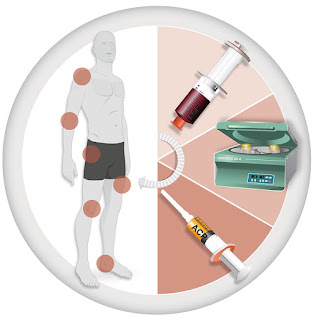𝗗𝗿.𝗝𝗮𝗹𝗮𝗽𝗮𝘁𝗵𝗶 𝗥𝗲𝗱𝗱𝘆 𝗠𝗮𝗻𝗱𝗮𝗹𝗮 -𝗢𝗿𝘁𝗵𝗼𝗽𝗮𝗲𝗱𝗶𝗰 𝗦𝘂𝗿𝗴𝗲𝗼𝗻
Platelet-Rich Plasma (PRP) Injections

Injections of platelet-rich plasma (PRP) are becoming more and more popular for treating a range of ailments, including sports injuries. A patient's own blood cells are used in the procedure to hasten the healing of a particular location.
What is platelet-rich plasma?
Platelet-rich plasma is made up of two components: platelets, a type of blood cell that is crucial to overall bodily repair, and plasma, the liquid portion of blood. In addition to their well-known clotting properties, platelets also contain growth factors that can promote cell proliferation, encourage tissue regeneration, or hasten healing in the treated area. Simply said, platelet-rich plasma is blood that has more platelets than usual.
Clinicians draw a blood sample from the patient and place it into a centrifuge, which quickly spins the sample, isolating the platelets from the other blood components and concentrating them inside the plasma. This process produces platelet-rich plasma.
\What is a PRP injection?
A patient's blood sample is used to make platelet-rich plasma, which is then injected into the wounded area, such as a tendon or knee, as needed. The doctor may occasionally utilize ultrasonography to direct the injection. To hasten the healing process, it is intended to raise the concentration of particular bioproteins or hormones, known as growth factors, in a particular location.
PRP injections' underlying process is not fully known. According to studies, the higher concentration of growth factors in platelet-rich plasma may stimulate or hasten the healing process, reducing the amount of time that injuries take to heal, the intensity of the pain, and even promoting hair growth.
What is PRP treatment used for?
PRP injections are used for a range of conditions, from musculoskeletal pain and injuries to cosmetic procedures.
Tendon, Ligament, Muscle and Joint Injuries
Many musculoskeletal injuries and diseases may be treated with PRP injections. For instance, adding PRP injections to a therapy plan can assist to speed up the healing process, lessen pain, and permit a quicker return to activities for chronic tendon injuries like tennis elbow or jumper's knee.
Shoulder injuries
- Rotator cuff tendonitis & partial tears
- Ant & Post ,band of IGHL
- ACJ,SCJ & C-C Ligament
- SLAP Lesion
Elbow injuries
- Lateral epicondylitis
- Medical epicondylitis
Wrist & Hand Injuries
- Ligament Sprains
- TFCC
Back & Hip injuries
- Facet joint arthritis
- Sacroiliac joint pain
- Hip girdle muscle pain
- Hamstring tendonitis
Knee Arthritis
- Patellar tendonitis
- Meniscus
- Ligament
(MCL, LCL, ACL, PCL), Cartilage defects
Ankle & Foot injuries
- Plantar Fasciitis
- Achilles tendonitis
- Ankle sprains
Post-surgical Healing
PRP was initially used by doctors to hasten the healing process following jaw or plastic surgery. Due to the lengthy recovery durations associated with treatments on these tissues, post-surgical PRP injections have now been expanded to assist in the healing of muscles, tendons, and ligaments.
Osteoarthritis
By altering the joint environment and lowering inflammation, PRP injections may help alleviate the pain and stiffness associated with osteoarthritis, but research is still in its early stages.
PRP Therapy Risks and Side Effects
PRP injections are low-risk procedures that often have few negative side effects. You should drink plenty of water and eat before the operation to avoid feeling dizzy because it involves drawing blood. You can suffer some discomfort and bruising at the injection site following the treatment.
Compared to other injectable treatments like corticosteroids, the chance of an allergic reaction is far lower with PRP injections because they are formed of your own cells and plasma. PRP injection dangers that are less frequent include:
- Bleeding
- Tissue damage
- Infection
- Nerve injuries